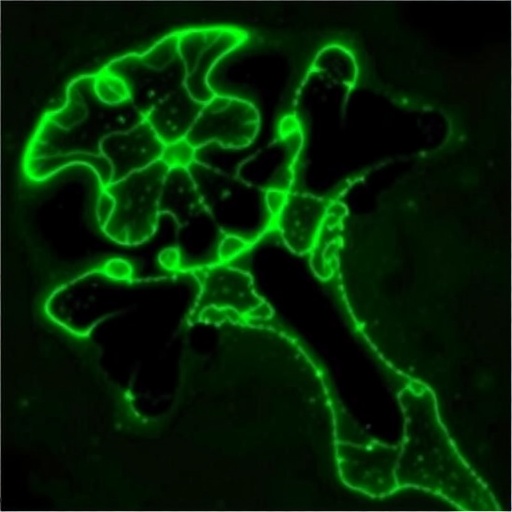Researchers continue to explore innovative routes to enhance neuroprotection and promote neurogenesis, the process of generating new neurons, particularly after nervous system injuries. A recent study that has captured considerable interest in the scientific community centers around the novel use of a plasmid hydrogel containing Brain-Derived Neurotrophic Factor (BDNF). This groundbreaking research, spearheaded by Huang et al., demonstrates promising results in a rat model of intracerebral hemorrhage, a severe condition marked by bleeding within the brain that leads to increased cell death and subsequent neurological deficits.
Intracerebral hemorrhage is a critical health issue affecting numerous individuals, often resulting in life-altering consequences. The brain, while remarkably resilient, can sustain significant damage from such events. The quest for effective therapies to mitigate the damage caused by intracerebral hemorrhage has led researchers to investigate various neuroprotective agents and delivery methods. The current study emphasizes the potential of the BDNF plasmid hydrogel as an innovative approach, capitalizing on the regenerative properties of BDNF, a critical molecule involved in neuronal survival, growth, and differentiation.
The researchers employed a specially formulated hydrogel to encapsulate the BDNF plasmid, ensuring that it could be effectively delivered to the targeted brain regions. This localized delivery is crucial, as it minimizes systemic exposure and maximizes the therapeutic effect directly at the injury site. The hydrogel acts as a scaffold, allowing for sustained release of the BDNF plasmid over an extended period, creating a microenvironment conducive to neuroprotection and repair post-injury.
The experimental design involved inducing intracerebral hemorrhage in a controlled setting, followed by the application of the BDNF plasmid hydrogel in the affected brain areas. Subsequent evaluations included assessments of neuroprotective effects, neurogenesis, and overall functional recovery. The findings showcased a marked improvement in neuroprotection, with reduced neuronal apoptosis and enhanced survival of progenitor cells, which are essential for neurogenesis.
In addition to promoting cell survival, the results indicated an increase in the proliferation of neuronal stem cells in the vicinity of the hydrogel application site. This is particularly noteworthy, as neurogenesis is a critical factor in recovery from brain injuries. By infusing the affected area with BDNF plasmids, the hydrogel not only protects existing neurons but also stimulates the generation of new neurons, which may contribute to functional recovery in the affected rats.
Moreover, the study delves into the intricate molecular mechanisms behind the observed improvements. BDNF exerts its effects through various signaling pathways, primarily by binding to the TrkB receptor, which activates downstream cascades responsible for neuronal survival and differentiation. The researchers hypothesized that the sustained release of BDNF from the hydrogel would create a signaling gradient, fostering an optimal environment for neuronal regeneration.
Through meticulous experimentation and analysis, Huang et al. provided compelling data supporting the efficacy of the BDNF plasmid hydrogel. Not only did they measure improvement in survival rates of neurons and neurogenesis, but they also reported functional outcomes. Behavioral assessments indicated that the rats treated with the hydrogel exhibited enhanced recovery when subjected to motor and cognitive tasks. This correlation between biological and functional improvements underscores the potential translational implications of the research.
As the scientific community eagerly anticipates further research based on these findings, the potential for clinical applications in treating intracerebral hemorrhage becomes increasingly promising. One of the study’s primary implications lies in its capacity to inform clinical strategies for treating brain injuries, offering a targeted approach to managing neurodegeneration and stimulating recovery.
Equally important is the safe and biocompatible nature of the hydrogel system used in this study. This aspect is critical for potential human applications, as any new therapeutic strategy must ensure minimal adverse effects. The engineers of this hydrogel have carefully considered its properties to maintain compatibility with biological systems while effectively delivering therapeutic agents.
The promising results of this research mark a significant milestone in neurotherapeutics, potentially paving the way for future innovations in brain injury treatment. Continued efforts will likely focus on the scalability of this technology, with the hope that similar methodologies can be adapted to other forms of neurological damage beyond intracerebral hemorrhage.
In conclusion, the work of Huang et al. shines a light on the potential of BDNF plasmid hydrogels as a therapeutic strategy for neuroprotection and neurogenesis in the setting of severe brain injuries. By harnessing the remarkable properties of BDNF and integrating them into a well-designed hydrogel system, the research not only advances our understanding of neurobiology but also holds promise for developing effective clinical interventions. As ongoing research progresses, the vision of improving outcomes for patients with brain injuries comes closer to fruition, transforming the landscape of neurotherapeutics.
Subject of Research: Neuroprotection and Neurogenesis
Article Title: BDNF Plasmid Hydrogel Promotes Neuroprotection and Neurogenesis in Rats with Intracerebral Hemorrhage
Article References:
Huang, A.PH., Hsu, YH., Chen, TH. et al. BDNF plasmid hydrogel promotes neuroprotection and neurogenesis in rats with intracerebral hemorrhage.
Sci Rep (2025). https://doi.org/10.1038/s41598-025-28577-3
Image Credits: AI Generated
DOI: 10.1038/s41598-025-28577-3
Keywords: BDNF, plasmid hydrogel, neuroprotection, neurogenesis, intracerebral hemorrhage, brain injury, stem cells, therapeutic strategies.




